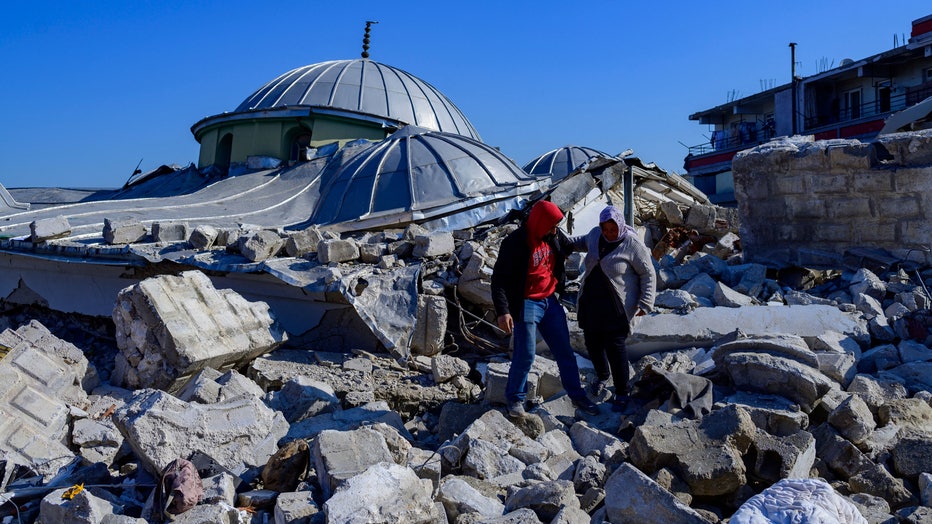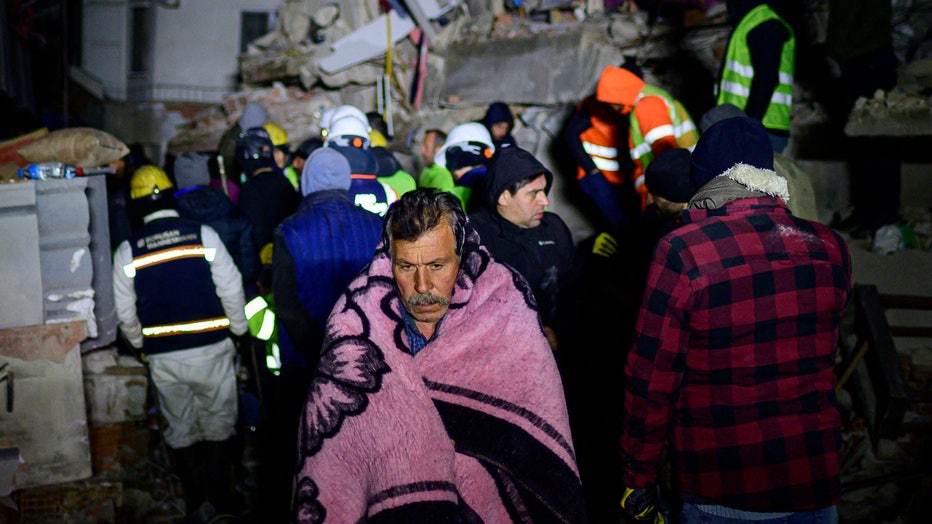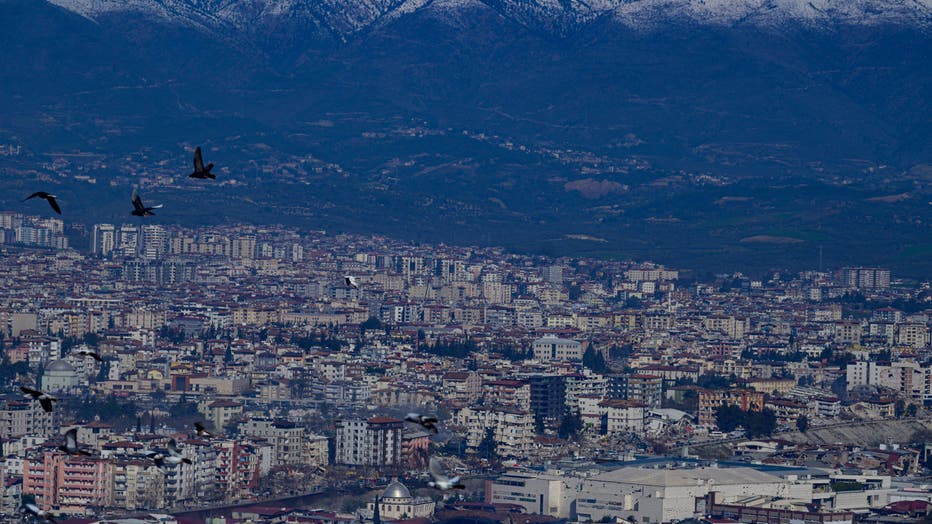Watch: Rescuers pull child from rubble 89 hours after Turkey earthquake
Rescuers pulled several people alive from the shattered remnants of buildings on Friday, some who survived more than 100 hours trapped under crushed concrete in the bitter cold after a catastrophic earthquake slammed Turkey and Syria, killing more than 20,000.
The survivors included six relatives who huddled in a small pocket under the rubble, a teenager who drank his own urine to slake his thirst, and a 4-year-old boy offered a jelly bean to calm him down as he was shimmied out.
But the flurry of dramatic rescues — some broadcast live on Turkish television — could not obscure the overwhelming devastation of what Turkey’s president called "the disaster of the century." Entire neighborhoods of high-rise buildings have been reduced to twisted metal, pulverized concrete and exposed wires, and the magnitude 7.8 quake has already killed more people than Japan’s Fukushima earthquake and tsunami, with many more bodies undoubtedly yet to be recovered and counted.
Four days after the earthquake hammered a sprawling border region that is home to more than 13.5 million people, relatives wept and chanted as rescuers pulled 17-year-old Adnan Muhammed Korkut from a basement in Turkey's Gaziantep, near the quake’s epicenter. He had been trapped there for 94 hours, forced to drink his own urine to survive.
READ MORE: War-torn Ukraine sending 87 rescuers to Turkey after deadly earthquake
"Thank God you arrived," he said, embracing his mother and others who leaned down to kiss and hug him as he was being loaded into an ambulance.
For one of the rescuers, identified only as Yasemin, Adnan’s survival hit home hard.
"I have a son just like you," she told him after giving him a warm hug. "I swear to you, I have not slept for four days. ... I was trying to get you out."

Local residents walk in the rubble of a destroyed mosque in Hatay, on February 10, 2023, after the 7.8 magnitude earthquake (Photo by YASIN AKGUL/AFP via Getty Images)
In Adiyaman, meanwhile, rescue crews pulled 4-year-old Yagiz Komsu from the debris of his home, 105 hours after the quake struck. They then turned to trying to reach his mother, according the HaberTurk television, which broadcast the rescue live. The crowd was asked not to cheer or applaud to avoid scaring the child, who was given a jelly bean, the station reported.
Elsewhere, HaberTurk television said rescuers had identified nine people trapped inside the remains of a high-rise apartment block in Iskenderun and pulled out six of them, including a woman who waved at onlookers as she was being carried away on a stretcher. The crowd shouted: "God is Great!" after she was brought out.
The building was only 600 feet (200 meters) from the Mediterranean Sea and narrowly avoided being flooded when the massive earthquake sent water surging into the city center.
There were still more stories: A German team said it worked for more than 50 hours to pull a woman alive from the rubble of a house in Kirikhan. In the hard-hit city of Kahramanmaras, two teenage sisters were saved, and video of the operation showed one emergency worker playing a pop song on his smartphone to distract them.
And the work continued: One trapped woman could be heard speaking to a team trying to dig her out in video broadcast by HaberTurk television. She told her would-be rescuers that she had given up hope of being found — and prayed to be put to sleep because she was so cold. The station did not say where the operation was taking place.
Even though experts say trapped people can live for a week or more, the chances of finding survivors in the freezing temperatures are dimming.

A local resident walks among the rubble of a collapsed building in Hatay, early on February 10, 2023, (Photo by YASIN AKGUL/AFP via Getty Images)
Still, the rescues Friday provided fleeting moments of joy and relief amid the misery and hardship gripping the shattered region where morgues and cemeteries are overwhelmed and bodies lie wrapped in blankets, rugs and tarps in the streets of some cities.
RELATED: Survivors of Turkey, Syria earthquake struggle to stay warm and fed
In Kahramanmaras, a sports hall served as a makeshift morgue to accommodate and identify bodies.
Temperatures remain below freezing across the large region, and many people have no place to shelter. The Turkish government has distributed millions of hot meals, as well as tents and blankets, but was still struggling to reach many people in need.
Across the border, Syrian President Bashar Assad on Friday made his first public appearance in an earthquake-devastated area of the country since the disaster. Assad and his wife, Asmaa, visited survivors at the Aleppo University Hospital, Syrian state media said. He then visited rescuers in one of the hardest-hit areas in the city.
Aleppo, already scarred by years of heavy bombardment and shelling amid the country's grinding civil war, was among the most devastated cities by the Feb. 6 earthquake.
World Health Organization Director-General Tedros Adhanom Ghebreyesus and Dr. Michael Ryan, WHO’s head of emergencies, were expected to arrive in the city later Friday to help support the delivery of assistance.
Assad's visit came a day after the first U.N. aid trucks reached rebel-held northwestern Syria since the quake, underscoring the difficulty of getting help to people there.
The winter weather and damage to roads and airports have hampered the response on both sides of the border. Some in Turkey have also complained that the government was slow to respond, a perception that could hurt Turkish President Recep Tayyip Erdogan at a time when he faces a tough battle for reelection in May.
Turkey’s disaster management agency said more than 18,300 people had been confirmed killed in the disaster so far in Turkey, with nearly 75,000 injured. No figures have been released on how many have been left homeless, but the agency said more than 75,000 survivors have been evacuated to other provinces.
More than 3,300 have been confirmed killed on the other side of the border in Syria, bringing the total number of dead to more than 21,600.
The death toll from the earthquake has eclipsed the more than 18,400 who died in the 2011 earthquake off Fukushima, Japan, that triggered a tsunami and the estimated 18,000 people who died in a temblor near Istanbul in 1999.

This photographe taken on February 10, 2023, shows a general view of the city of Hatay, Turkey (Photo by YASIN AKGUL/AFP via Getty Images)
Some 12,000 buildings in Turkey have either collapsed or sustained serious damage, according to Turkey’s minister of environment and urban planning, Murat Kurum.
Engineers suggested that the scale of the devastation is partly explained by lax enforcement of building codes, which some have warned for years would make them vulnerable to earthquakes. The problem has been largely ignored, experts said, because addressing it would be expensive, unpopular and restrain a key engine of the country’s economic growth.
Mustafa Turan counted 248 collapsed buildings between the airport and the center of Adiyaman after he rushed to his hometown from Istanbul following the quake.
The journalist said Friday that 15 of his relatives had been killed, and scores of people were sleeping outside or in tents.
"At night, about 4 a.m., it got so cold that our drinking water froze," he said.

